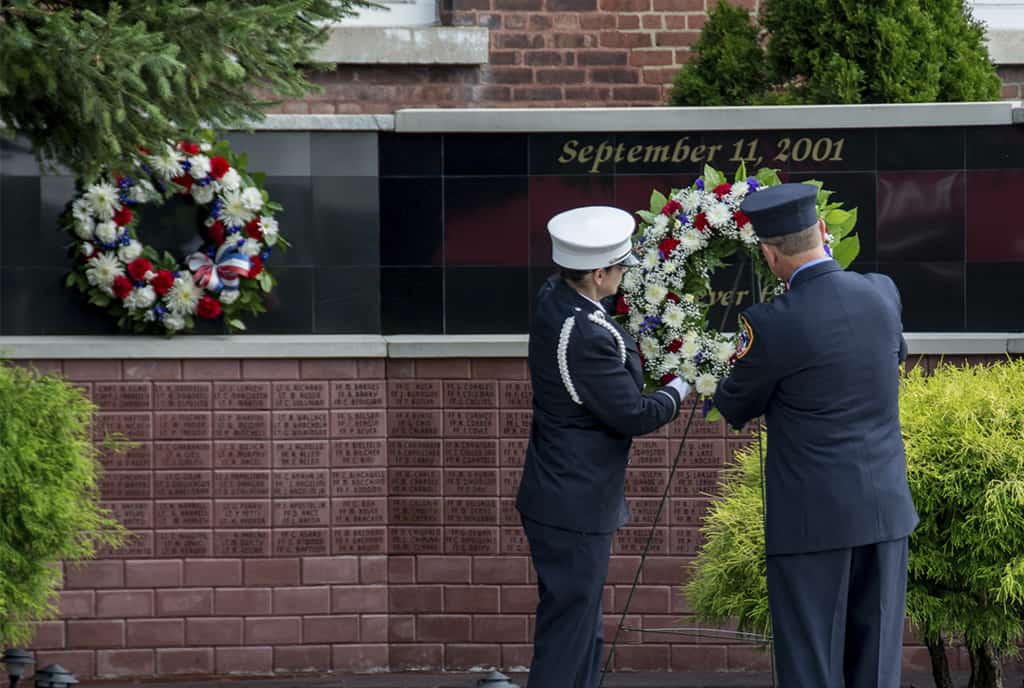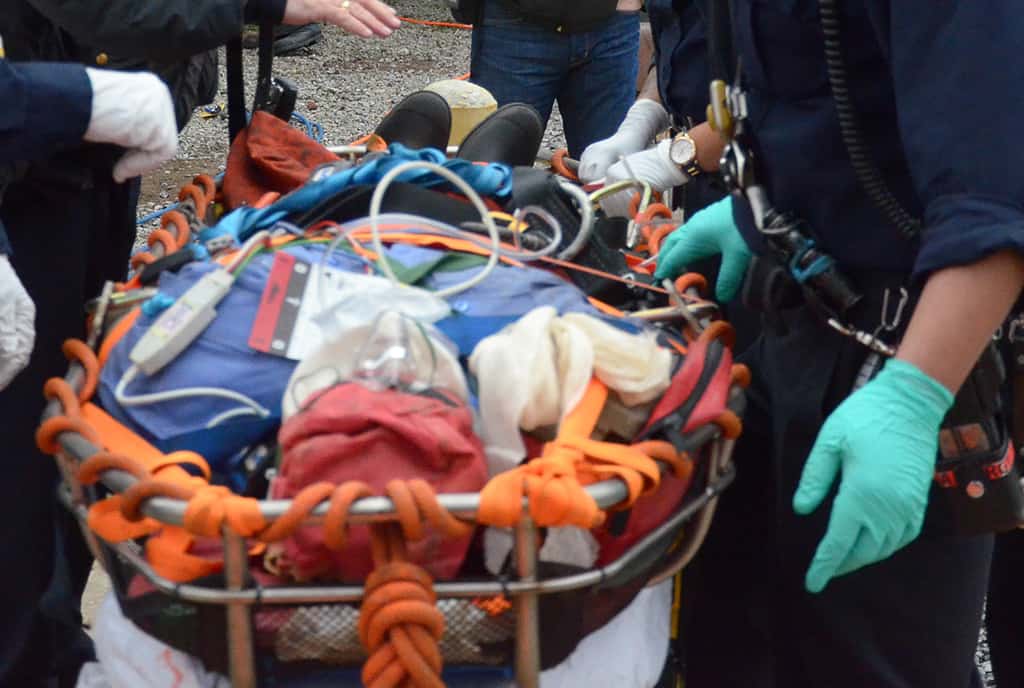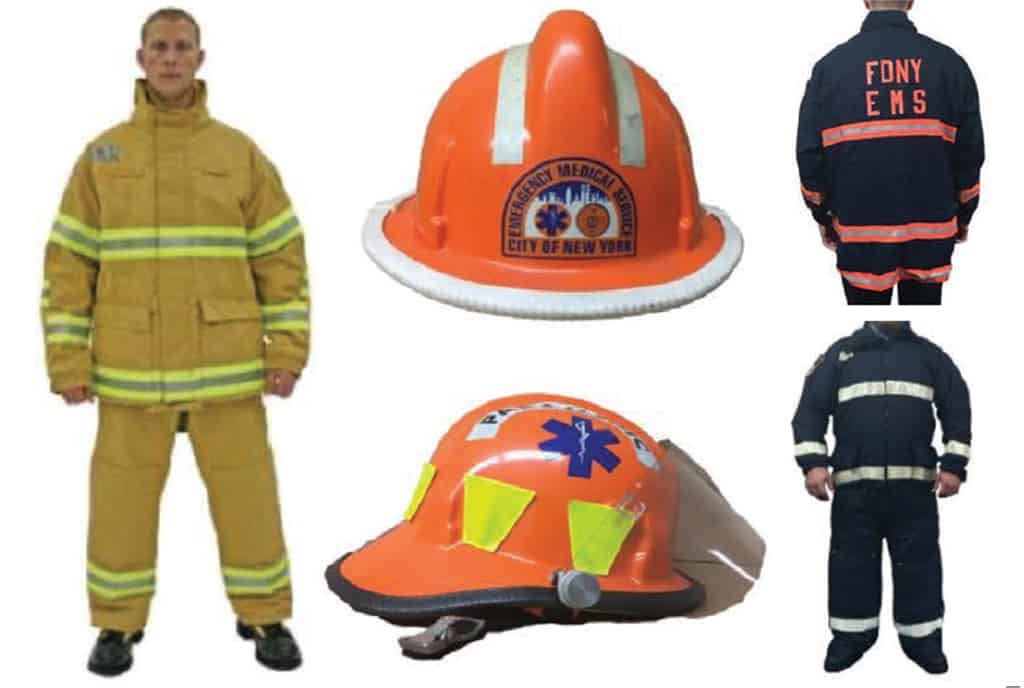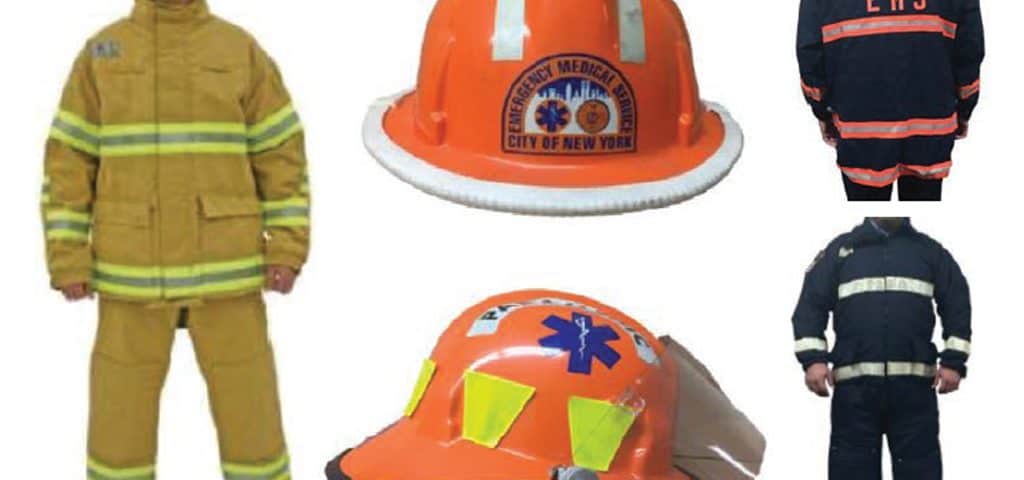
The 10-12 for 3/2016
October 4, 2016
Call Review: Keys to Resilience for Post-Traumatic Stress Disorder (PTSD)
October 4, 2016Safety First: Protecting Our Own: An Evolution of FDNY EMS Personal Protective Equipment (PPE)
Early 1980s
Plastic MSA helmet and work gloves1985-1986
Orange safety coatEarly 1990s
Blauer high-visibilty safety coat (orange with silver striping)1996
Merger of NYC EMS/ HHC and FDNY1997
Mayor authorizes the issuance of body armor to EMS members.2001
Terrorists attack WTC2004-2006
Pilot program of EMS PPE2010
Traffic safety vests2016
Present day EMS PPE ensemble.

After 9/11, FDNY made improvements to EMS personal protective equipment (PPE).
EMS call volumes continuously have increased over the years, while the types of operational hazards in the workplace have become more comprehensive and complex. This growth in both call volume and hazard types has caused a drastic change in how agencies approach the need for EMS safety equipment and apparel, advancing the development of personal protective equipment (PPE) for emergency medical service providers. To establish context and an understanding of what led to current protective equipment standards, both nationally and in New York City, we first must discuss the history and development of protective equipment in the EMS workplace. When we arrive at discussing our present-day equipment, we will see how this ensemble best meets modern environmental challenges, affording our members the highest levels of safety possible.
1980s
In this era, New York City EMS was a part of the Health and Hospitals Corporation (HHC) and safety awareness was minimal for an emergency service-providing agency. The general expectation during this period was that EMS members would have patients removed from high-hazard environments and brought to them for treatment in an area deemed safer for emergency medical care provision. This mind-set often led to delays in critical care interventions or, in some instances, required members to operate in questionable environments–potentially compromising their health and safety.
Field personnel were issued plastic yellow helmets and thin, calfskin safety gloves, while Officers donned similar white safety helmets. All members wore cotton uniforms and the use of disposable examination gloves was minimal to non-existent, as this was not yet the standard. During the mid- to latter part of the 1980s, the onset of the AIDS epidemic in New York City ultimately led to the use of latex gloves as a universal precaution during the provision of all emergency medical care.
In the mid-1980s, New York City EMS members began being issued orange safety coats with reflective stripe and lettering. This coat, along with a badge, calfskin gloves and safety helmet, became the four-piece apparel ensemble, which was service-issued and did not have to be purchased personally from a local uniform vendor. The development of this safety coat facilitated higher visibility while operating at night and became a benchmark for future EMS safety apparel improvements. The jacket was found favorable by many members in the field due to its ability to repel rain, the presence of a concealable hood and a removable down vest liner for the winter season. The jacket was long, however (comparable to a trench coat), and uncomfortable to wear in some situations. It also offered minimal protection from blood-borne pathogens (BBP).
In 1986, after identifying the need to provide increased head protection, the New York City Health and Hospitals Corporation began issuing structural Firefighter-rated helmets with flip-down visors to all EMS personnel. This initiative provided members with eye protection for the first time while operating at mass-casualty incidents. The improved safety rating of the helmet also drastically increased the level of protection afforded to personnel while operating at structural fires and other incidents with potential falling debris hazards.
1990s
On March 17, 1996, NYC EMS was removed from the control of the Health and Hospitals Corporation and merged with the New York City Fire Department. Shortly after this merger, members of the newly created FDNY EMS Bureau were issued blue, nylon, cordura jackets with white reflective striping. This evolution of the EMS jacket was the first to be produced by a manufacturer of Firefighter apparel and invoked the style and appearance of classic Firefighter bunker gear. The new bunker-style jacket provided increased visibility and better protection from the elements, compared to its pre-merger predecessor. While this jacket was purchased and issued to members at Department expense, members could purchase matching detachable hood and pants to complete the ensemble.
This garment’s subsequent generation, issued some years after the merger, was updated to include orange and silver, screened reflective striping in place of the single-color white striping. Although no formal policy was enacted mandating when this jacket would be worn, once issued, members were expected to wear it during any incident in which a helmet was being used. This ensemble was designed to be blood-borne pathogen-resistant and had improved tear resistance, but was not flame-resistant. The lack of flame resistance made the jacket less than ideal while operating at incidents with a threat of fire, as well as while placing road flares at motor vehicle accident scenes.
On one dark night in October of 1997, an incident occurred that permanently changed the type of threats considered commonplace for members of the FDNY EMS workforce. EMT Chris Kelleher stopped to assist a civilian who was being assaulted in the Kingsbridge Heights section of the Bronx. The assailant, who was brandishing a knife, slashed EMT Kelleher and attempted to stab him several times. Fortunately, EMT Kelleher—similar to many EMS members assigned to high-crime neighborhoods–had purchased his own ballistic vest and worn it on this occasion. After the incident made front-page headlines, Mayor Rudy Giuliani, who had orchestrated the FDNY-EMS merger, allocated $1 million to outfit the FDNY EMS workforce with ballistic vests.
2000s
On September 11, 2001, members responded to the World Trade Center attack wearing whatever personal protective equipment they had been issued to date. The lack of a respiratory component to adequately protect them from the toxic dust became a long-term health consequence for many members who were present during the collapses and the aftermath. During the subsequent nine-month recovery operation, members provided care to fellow emergency service workers and processed human remains in a makeshift mortuary, all while exposed to the yet fully identified hazards of the World Trade Center dust.
In a post-September 11 world, it became clear to FDNY leadership more needed to be done to protect EMS members. The repercussions of the terror attack, which killed 343 FDNY members, left looming concerns regarding the safety of members during future attacks. As emergency service personnel present during the recovery began falling ill with post-9/11 illnesses and diseases, it became apparent that PPE for EMS members had to become a major focus of the Department’s Research and Development Unit. The mandatory future components of EMS PPE included BBP-resistant jacket and pants, Air-Purifying Respirator (APR), tear-resistant extrication gloves and military-grade work boots.
PPE Jacket and Pants
Upon conclusion of an extensive pilot program, EMS members became outfitted with the current, tri-certified ensemble (jacket and pants), built according to NFPA 1951 (USAR), blood-borne pathogen-resistant, NFPA 1999 (EMS) and liquid splash/hazardous materials NFPA 1992 (haz-mat). The NFPA 1999 certification outlines protective clothing for emergency medical operations. This standard ensures protective qualities against blood-borne pathogens and offers protection during contact with other body fluids and waste. The NFPA 1951 certification is for USAR (urban search and rescue) operations and requires flame-resistant protection. This gear is designed for flash fire protection (900 degrees for three seconds). The coat comes with a winter liner designed for warmth, but not protection from exterior heat. The NFPA 1992/1951 certification is for liquid splash-protective ensembles and clothing for hazardous-materials emergencies (USAR).
The materials and seams are tested for penetration from several chemicals, but do not afford protection from chemical vapors. The jacket and pants are made from Polybenzoxazole (PBO), which is an engineered blend of 40 percent Zylon and 60 percent Texhnora, a durable and chemical-resistant mix of fibers that weighs significantly less than the fabric of the previous jackets and pants. This engineered blend’s natural color is tan and does not hold dye well, according to the manufacturer’s representative. The color has served the Department well in that members of Fire Operations seeking EMS personnel during critical incidents are taught to “scan for the tan.”
Helmet, Gloves and Boots
The current-issue helmet has not had major changes since it was adopted in 1986 by NYC EMS-HHC. It is a structural-rated NFPA 1971 helmet with some thermal and impact protection. The helmet is comprised of a chip- and crack-resistant resin material and a one-hand, quick-release buckle on the chin strap. A variation of this helmet is assigned to Rescue Paramedics, who are issued a shorter brim version, allowing it to be worn during rope rescue operations without interference. All members also are issued extrication gloves that are padded for abrasion and cut and tear resistance. FDNY currently issues two different styles of work duty boots; one of them is a low-cut (four-inch), lace-up, NFPA 1999-2013-compliant boot with a steel safety toe. The alternate boot is a high-cut (eight-inch), lace-up and side zip, NFPA 1999-2013-compliant boot with a non-metallic toe.
Air-Purifying Respirator Mask
On September 11th, FDNY EMS members were left scrounging for every N95 mask that they could find. The snow-like World Trade Center dust saturated the masks quickly, requiring constant replacement. Following the rescue and recovery efforts, research was performed to identify an air-purifying mask that could be worn in toxic environments. This research led to issuing the MSA Millennium mask with detachable canister, which can be stored in a wearable bag. Although the non-Haz-Tac-certified members issued this mask still cannot operate in oxygen-deficient atmospheres, it does provide facial and respiratory protection at a military-grade level, affording better protection during potential future attacks.
In the years that followed the attacks on the World Trade Center, the McKinsey report, Increasing FDNY’s Preparedness, was written to review the FDNY response and make recommendations on system-wide improvements. One recommendation was to increase operational capabilities of EMS City-wide for hazardous-materials incidents. This initiative ultimately combined the personal protective ensemble with extensive training at the Hazardous-Materials Operations level to create a new minimum training standard for FDNY EMS members, satisfying the McKinsey Report recommendation.
2010s
The Department began issuing high-visibility, reflective/fluorescent vests to comply with the Federal Worker Visibility Act. These vests, produced by the manufacturer of the Department’s PPE ensemble, must be worn while operating on the scene of all motor vehicle accidents.
A FDNY Officers Management Institute (FOMI) project examined the use of current EMS helmets with issued flip-down visors and members’ safety. Deputy Assistant Chief Janice Olszewski made a compelling case for changing from the flip-down visor to military-style goggles. The changeover would reduce potential eye injuries, as well as the extensive repair cycle for helmets with cracked visors.
Also in 2014, at the height of the Ebola outbreak in West Africa, the FDNY took measures to ensure EMS members were protected from the latest threat. Members of the Special Operations Command (SOC) assisted the Department in identifying personal protective equipment, such as protective suits, boots and hoods that could be worn while treating suspected Ebola Virus Disease (EVD) patients. The Kleenguard A-60 suits shown in the first edition of Pro EMS, as well as an EVD-rated APR filter canister, were issued to all members in anticipation of a potential outbreak.
Future of Personal Protective Equipment
The FDNY constantly is evaluating and re-evaluating the use of PPE in our rapidly changing and complex mission of member life safety. Currently, FDNY is evaluating a work duty uniform in an effort to improve both member safety and comfort. Future variations of the personal protective ensemble issued to FDNY EMS members will incorporate items to address the constantly changing threats faced by the Department in the form of disaster, terrorism and disease.
Bibliography
1. http://www.nydailynews.com/archives/news/mayor-emts-bulletproof-vests-article-1.770234
Mayor: EMTs gets bulletproof vests, Maureen Fan, Daily News (New York City Edition), 10/6/1997
2. Interviewee: James Booth, Rank: Chief of EMS, FDNY, August 2016
3. McKinsey Report, Increasing FDNY’s Preparedness, Part III: Additional Issues to be Addressed
4. FDNY Strategic Plan 2015-2017, Pages 19-20, Objectives 1.4
5. FDNY FOMI 2008-2009, “Fire and EMS Best Practices Around the World,” Chief Janice Olszewski, et al
6. http://us.msasafety.com/Air-Purifying-Respirators-(APR)/Full-Face-Masks/CBRN-and-Riot-Control-Gas-Masks/p/000050001700001500
7. MSA Millennium Full Face Masks Specifications
About the Authors
Lieutenant Yonatan Klein has served the FDNY since 2007, starting with an assignment to Station 47, Far Rockaway. In March 2009, Lieutenant Klein graduated from the FDNY Paramedic Original program and was assigned to Station 54, Springfield Gardens. October of 2010, he was assigned to EMS BOT and became a CIC (certified
instructor coordinator) and helped in the initial stages of simulation and high fidelity training. He was elevated to the rank of Lieutenant in September 2014 and assigned to Station 43, Coney Island. In October 2015, he was assigned to the Safety Command’s Research and Development Unit.
Lieutenant Brendan Dean has just completed his 29th year of service with the Emergency Medical Service. He was previously assigned to EMS Battalion 8, where he served as a field supervisor. He has been a Paramedic for 23 years and served the community of Harlem for 11 of those years, prior to his promotion to Lieutenant. Lieutenant Dean currently is detailed to headquarters as the EMS liaison to the Safety Command.
Read More from Pro EMS 3rd/2016


